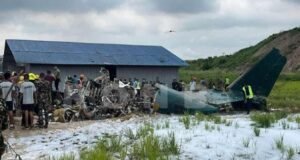
The Israeli military said it had struck some 80 sites across Gaza by early Saturday morning, including a security headquarters building. Air raid sirens sounded throughout the night in southern Israel, with militants firing some 30 rockets, the military said.
It said about 10 rockets were intercepted by its Iron Dome rocket defense system, two landed prematurely in Gaza and the rest fell in open areas. Israel’s military chief, Lt. Gen. Gadi Eisenkot, convened an emergency meeting of top security officials, the army added, without elaborating.
There was no word on injuries as a result of the rockets and airstrikes.
Islamic Jihad, a smaller militant group, implicitly claimed responsibility for the rocket fire. It issued a statement saying that it normally exercises restraint, but it “can no longer stand idle before the continued killing of innocents and bloodshed by the Israeli occupation.”
It was not immediately clear whether Islamic Jihad, which sometimes acts independently of Hamas, had coordinated the rocket fire with Hamas. But Israel holds Hamas, which seized control of Gaza in 2007, responsible for all fire emanating from the territory.
The sides have fought three wars over the past decade, and Israel and Egypt have maintained a stifling blockade on the territory to weaken Hamas. The Hamas-led weekly protests along the Israeli border have been aimed in large part at breaking the blockade, which has devastated the Gaza economy.
On Friday, thousands of Palestinians gathered at five locations along the boundary, burning tires and throwing rocks, grenades and firebombs at Israeli troops who responded with tear gas and occasional live fire.
The Israeli army said some suspects briefly crossed the fence.
Three of the dead were reported in Khan Younis, in southern Gaza, according to the Gaza Health Ministry. Witnesses said that dozens of protesters approached the fence there.
In northern Gaza, a 27-year-old man died after being shot in the head, the ministry said. It added that 170 other protesters sustained various injuries.
Hamas, an Islamic militant group sworn to Israel’s destruction, had previously scaled down the protests as Egypt stepped up its efforts to secure calm.
On Wednesday, Egyptian intelligence officials met representatives of Palestinian factions in Gaza. Loay Qarouti of the Popular Front for the Liberation of Palestine General Command said the mediators asked them “to protect the lives of protesters and minimize losses among them.”
Egypt wants to restore calm in order to pursue the broader goal of Palestinian reconciliation between Hamas and the West Bank-based administration of President Mahmoud Abbas. The internationally recognized Abbas lost control of Gaza in the 2007 takeover.
But Hamas maintains it wants a full lifting of a crippling blockade Israel and Egypt imposed on Gaza to isolate the Islamic movement.
The blockade has made it increasingly difficult for Hamas to govern. Widespread desperation among Gaza’s 2 million residents — who get only a few hours of electricity a day and undrinkable tap water, in addition to suffering from soaring joblessness and limited freedom of travel — fuels their participation in the Hamas-orchestrated protests.
Since the marches began six months ago, at least 160 Palestinians present or taking part in the protests have been killed. A Gaza militant fatally shot an Israeli soldier in July.
Israel accuses Hamas of using the large protests as cover to stage border infiltrations and attacks. It says it is defending its border and accuses Hamas of exploiting young protesters and encouraging them to risk their lives in order to increase pressure to ease the blockade.
Israel has come under heavy international criticism for what many see as excessive use of force and the large number of unarmed people who have been shot.
In the West Bank, a 33-year-old Palestinian man was killed and nine others wounded by live rounds, one in critical conditions, as the Israeli forces confronted stone throwers in a village near Ramallah city, doctors said.
 Weekly Bangla Mirror | Bangla Mirror, Bangladeshi news in UK, bangla mirror news
Weekly Bangla Mirror | Bangla Mirror, Bangladeshi news in UK, bangla mirror news







